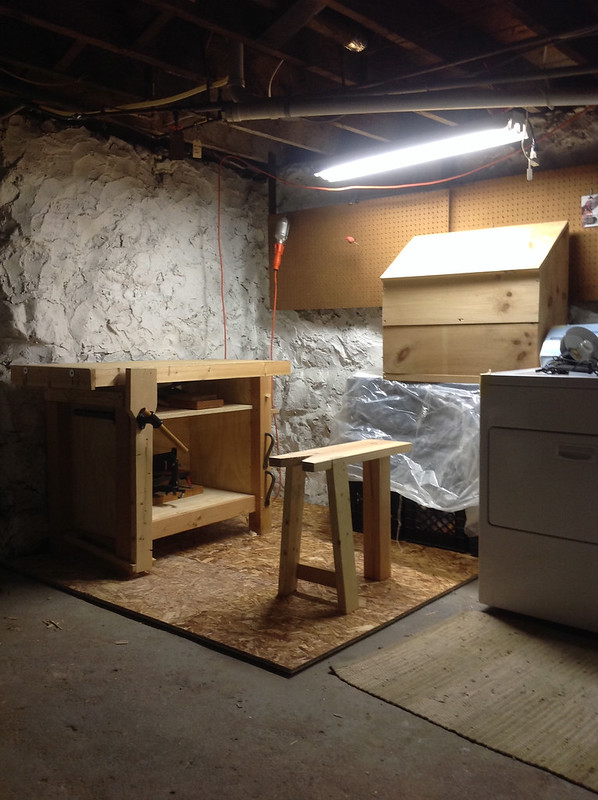Someone on
WoodworkingTalk.com asked recently what limitations there were on what could be done with hand tools. I started writing with the intention of just saying "There are none, everything used to be done that way." I wound up with something long enough that I've decided to put it here, as well.
I started out down the power tool route, then did a 170 (not quite a 180
-- I still use a few power tools) after seeing a presentation by Paul
Sellers and some videos of a few other hand tool workers. I said I use a
few power tools, still: they are a corded electric drill, a drill
press, a band saw, and a circular saw. I've also got a chop saw, but
it's really a rough carpentry tool... I could spend a month calibrating
it, and I still don't think it would cut a perfect 90 degree angle. If I
were starting over I wouldn't buy the handheld drill or the circular
saw, so I'm leaving them out of my math. Here's my take.
Anything you could make with power tools, you could also make with hand
tools. Anything you could make with hand tools, you could also make
with power tools. The question of "Can it be done?" is therefore pretty
meaningless. So what's the difference? Cost, convenience, and
complexity.
Cost: Hand tools are arguably cheaper. I'm pretty sure I'm less than
$800 into my hand tool kit, and the only things left that I know I'll
need sooner or later are a pair of router planes and some new drill and
auger bits. I'm including the two power tools I anticipate using
regularly in that number, by the way -- a band saw and a drill press.
I'll probably buy the planes and bits new, which means I'll probably add
another $300-350 to my total. If you buy all new, instead of mostly
cheap and used like I have, you can still probably get a good kit for
under a grand, just slightly less complete. On the other hand, a nice
solid table saw can run upwards of $500 on its own, and you'll still
need a router, router table, bandsaw, drill press, miter saw, and so on.
I priced it out. Buying good quality new tools, or even high quality
used tools, gets expensive.
Convenience: In many cases, power tools are more convenient. I have a
band saw for doing long rip cuts, long curves, and resawing. I have a
drill press for drilling perfectly aligned holes of any size. In other
cases, hand tools are more convenient. I don't know of a way to come up
with the same end-grain surface that a hand plane used with a shooting
board will get. For cutting a small board to exact length, I'd rather
use a carcasse saw and a bench hook than a miter saw: it's faster, more
accurate, and less prone to throwing little bits of wood around the
shop like buckshot. And in just about every case, the hand tool will be
quieter and cleaner, which is a nice bonus.
Complexity: In my mind, this almost always goes in favor of hand tools.
Complex compound miters are relatively easy with hand tools: draw the
line you want to cut on, put the piece of wood in a vise, and cut it.
With power tools, you frequently end up needing complex jigs to do the
same job. Given the need to cut a piece to an exact length, I can
measure it out on the piece, mark it, and cut. I find that a lot easier
than setting up a table or miter saw. Most operations, though, aren't
any less complex either way: cutting curves with a bow saw or a band
saw are the same except in terms of effort. Ripping is simple with hand
or power tools, it's just more work with hand tools. There's one
specific place this goes entirely in favor of power tools: production
line work. If I need a hundred boards cut to the same length, I'd far,
FAR rather use a miter saw with a stop block than a hand saw. It's
faster, it's easier, and it's simpler. No question. If I need to
produce a huge run of identical molding, a router or shaper is the
simpler answer by far. There's really no room for debate, it's just
true.
So. What does all that mean? It means I value quiet and simple more
than I value fast and physically undemanding. I like being able to
listen to the radio while working, and I don't mind that woodworking
makes me sweat. (I need the exercise anyway.) I also, so far, have
built small one-of-a-kind things; if I wanted to make a run of ten
identical dining room chairs, or anything else for that matter, I might
well re-consider. You might find the value equation goes the other way.
I really couldn't tell you. But I can state that anything you can do
with one type (power or non-powered) of tool, you can also do with the
other type. It just may take more work.

